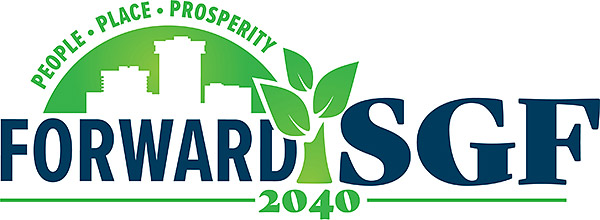Connecting To Nature
Forward SGF champions enhancing outdoor recreation opportunities, sustainable development, and ecotourism to better connect residents, discussed in Chapter 11: Parks, Greenways, and Natural Resources.
A key initiative of Forward SGF is to better connect residents with nature and recreational opportunities. Springfield’s most significant natural areas, community parks, sports complexes, recreational facilities, and community and educational centers that draw residents and regional visitors should continue to be maintained and enhanced. Connections among destination amenities should be prioritized through a comprehensive trail network. Opportunities abound to promote the City’s unified brand through signage, wayfinding, amenities, and landscaping with native plants. Highlighting natural landscape features prevalent in the local area, such as cliffs and boulders native field stone, caves, karst topography, streams and waterways, trees, and wildlife habitat areas, can create interesting and memorable landmarks that serve as navigation guides within the park system. By increasing connections to the natural environment, Springfield residents can lead healthier lifestyles and enjoy enhanced quality of place.
The City has entered a contract with a consulting firm to facilitate and draft an update to the Zoning and Development Code, which will provide the City with the regulatory framework essential to implement many of the recommendations outlined in the Comprehensive Plan.
The City will begin the process of identifying new infrastructure projects that will be funding over the course of the next 5-years. Projects included will have a greater emphasis on quality of place and when possible, a connection to the natural environment either directly or by way of multimodal improvements.
See below projects that are prioritizing connection to nature.
Chapter 7 – Housing & Neighborhoods
- Goal 1. Support the Creation of Complete Neighborhoods
- (1.1) Create and Expand Neighborhood Amenities
- (1.2) Foster Walkable Neighborhoods
- (1.3) Beautify Neighborhoods
Chapter 8 – Economic Development
- Goal 3. Promote Reinvestment in Springfield’s Commercial Corridors and Key Gateways
- (3.1) Prioritize Corridor Improvements
Chapter 9 – Transportation & Mobility
- Goal 3. Integrate Transportation and Land Use to Support Mobility and Placemaking
- (3.3) Enhance Community Character and Placemaking
Chapter 10 – Infrastructure & Community Facilities
- Goal 3. Develop Infrastructure and Community Facilities in a Sustainable Manner
- (3.1) Apply Sustainable Development Practices
- (3.2) Identify, Promote and Protect Natural Infrastructure
- (3.3) Improve Water Quality
- Goal 6. Foster public ownership and community identity towards Springfield’s infrastructure and community facilities as they continue to support the beautification of the city.
- (6.2) Beautify through Infrastructure
Chapter 11 – Parks, Greenways, & Natural Resources
- Goal 1. Establish a Comprehensive Trails Network to Enhance Physical Connections Between Springfield’s Neighborhoods, Natural Areas, and Key Destinations
- Goal 2. Equitably Integrate Quality Public Spaces Throughout the City
- (2.4) Ensure a Connection to Nature in New Development and Redevelopment
- Goal 3. Promote Sports, Recreation, and Ecotourism through Branding and Facility Upgrades to establish Springfield as a Gateway into the Ozarks, while Boosting the Local Economy
- (3.1) Create a Unified Brand
- (3.3) Build on Springfield’s Recreational Experience
- Goal 4. Ensure Sustainable Growth and Environmental Stewardship by Conserving the City’s Natural Resources, while Fostering a Sense of Community Responsibility and Pride through Education and Immersive Experiences.
- (4.1) Increase Environmental Stewardship and Protections.
- (4.2) Promote Sustainable Development
- (4.3) Become a Leader in Sustainability in Southwest Missouri
- (4.4) Leverage Water Resources for Recreation
- (4.6) Preserve and Enhance the Urban Forest
- (4.7) Leverage natural features for public spaces
















